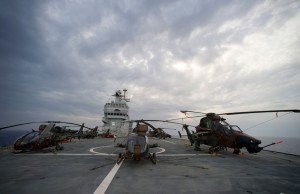2012-08-10 By Murielle Delaporte
Based on interviews with two of the operational leaders for the assault and maneuver helicopter battalion operating off the French aircraft carriers — BPCs (Bâtiment de Projection et de Commandement) — during the Libyan operation, it is clear that there are challenges and opportunities which air mobility of this sort brings to mission success.
Most frequently, the ALAT is part of a ground operation.
But in the operations off of Libya, the ALAT was operating by itself as the lead element. And it did so in the context of an air-naval operation, not in a ground assault support role.
The ALAT succeeded even though it was operating in a situation for which it had only trained in a simulated environment.
But in this case, the capabilities and operational approach allowed for a successful adaptation in the heart of the darkest nights possible. In the Libya operations, the helicopter battalions used engagement procedures typical of the ALAT in the reconnaissance and raiding ground missions for which it has been used most often.

In the Libyan operation, the ALAT was not just supporting the strike, it was the core strike element, as the ALAT was not to insert or support ground troops but to strike ground targets. As members of the French forces commented: “From June on, French Army Aviation shaped the wave of attack.”
The stress was significant on the operational crews aboard the Tonnerre and the Mistral. The operations and the logicians had to form a seamless team to be able to achieve mission success. If one could sum up the key to mission success, it would be unit cohesion and coherence.
The team was very cohesive as a result of the intense preparation for the mission and the psychological preparation during the mission. The land-based force and operating force worked together, as a whole – pilots and logisticians – adapting the Tigers to their first sea-based mission.
Some quotes below are taken from the interviews with Lt. Col. V., who led the air mobile operations from the Tonnerre BPC during the first phase of the operation and Captain R. who was Tonerre’s chief logistics officer.
The Tonnerre BPC operated in the initial phase of the operation and then the Mistral BPC took over at the end of July 2011.
According to Captain R “Our soldiers were put under constant stress during the operation, sleeping only three hours to five hours daily during the entire two half months during the operation. Success was achieved due to the preparation prior to the operation.”
The preparation of the units prior to the operation, according to Lt. Col. V, was shaped by “years of training, operational preparation and by real and simulated exercises as well as from years of deployment overseas. This enabled the personnel that originated from nine different units, and who were then embarked on the Tonerre, to work together for the first time in operational harmony.”
For the ALAT personnel who have been heavily engaged in overseas operations during the past few years, training and conditioning has been crucial to operational success in the Libyan operation. But in contrast to past operations, according to Lt. Col. V the helicopters operated alone in engaging enemy forces.
“Contrary to Afghanistan, we were not deployed to support or escort another unit; we were operating alone in direct contact with the enemy and operating at very low altitudes. We had to bring the fight where no one else was operating — in our night operational mode….
In this operation, the consequences from a crew falling into an enemy’s hands would have led to a media defeat. But we had to be prepared for this risk. We did not want to be in the situation similar to what the Americans experienced in Mogadishu during Operation Restore Hope in 1993, an event that forced President Clinton to withdraw U.S. troops from Somalia. I would have to consider such an event as a personal failure. But we had to prepare psychologically for this risk. That is why one of the first things I said during our first meeting was that ‘We are going together and returning together, even if not alive.’
I wanted our forces to understand that we should be prepared for the ultimate sacrifice. The value of the courage of the group was a significant element of the operation.
The combination of the group’s tactical, technical and moral assets was the key to success. We were 178 on the ship and we were putting our strength and our vulnerabilities into this high intensity war, and everyone stepped up to the plate and delivered their best.”
Beyond the commandos who were there to secure the zone and to recover forces, the Immediate Extraction (IMEX) Puma team aboard the ship had on-board medical personnel. Colonel V noted, “We know that the first 10 minutes of medical treatment are crucial. We had a medic on board who would treat any casualties first to prepare for treatment by an advanced medical team.”
Thus a key element of the operation was our preparation for the extraction of personnel and the follow-on medical support.
the Lt. Colonel emphasized, “My responsibility was to prepare the crew physically and psychologically for a night operation to bring our troops back on board the ship, no matter what happened. Each patrol was organized to be able to recover adjacent forces, and to know that their comrades were nearby and would do anything for them. With this kind of preparation, fear becomes a strength thus you gain an essential key to combat and fight better. The psychological side is fundamental, because at then end of the day it is a human affair….”
Selections from “Le Group Aérombile pendant Harmattan: “gagner et ne rien perdre” from Soutien Logistique et Défense (Summer 2012).
Preparation of helicopters on the ship Tonnerre for French Army operations in Libya .
And for a video of a French tiger recovering a flag from a Libyan rebel.


